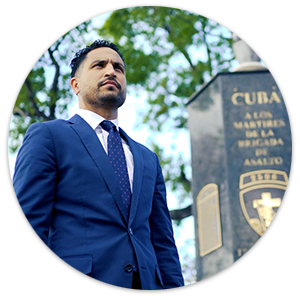In Florida, the safety of pedestrians is of paramount importance. However, accidents involving pedestrians are unfortunately common, and they can lead to severe injuries or even fatalities. When such accidents occur, determining liability can be a complex process. This complexity is heightened by Florida’s adherence to the comparative negligence standard, which plays a crucial role in how pedestrian accident cases are resolved. Understanding how comparative negligence works in Florida pedestrian cases is essential for anyone involved in such incidents, as it can significantly impact the outcome of a claim for damages.
Richard Guzman’s expertise focuses on one primary objective: to offer tactical legal analysis, guidance, and result-driven solutions. The Guzman Firm is dedicated to providing you with the knowledgeable and competent counsel you deserve.
Attorney Richard Guzman
Understanding Comparative Negligence
Comparative negligence is a legal doctrine that allocates fault among the parties involved in an accident based on their respective contributions to the incident. In Florida, the pure comparative negligence rule is applied, meaning that a party’s recovery for damages is reduced by their percentage of fault. This rule stands in contrast to states that follow either a contributory negligence rule, where any fault bars recovery, or a modified comparative negligence rule, where recovery is barred if a party’s fault exceeds a certain threshold, typically 50 percent.
Under Florida’s pure comparative negligence system, a pedestrian who is injured in an accident can still recover damages even if they are partially at fault. However, the amount they can recover will be reduced in proportion to their degree of fault. For instance, if a pedestrian is found to be 30 percent at fault for the accident, their potential compensation will be reduced by 30 percent. This system aims to distribute the financial burden of an accident more equitably based on the behavior of all parties involved.
Application of Comparative Negligence in Pedestrian Cases
Pedestrian accidents often involve a variety of factors that can influence the determination of fault. In many cases, the driver of the vehicle involved in the accident may be found at fault for reasons such as speeding, failing to yield the right of way, or driving under the influence of alcohol or drugs. However, pedestrians also have a responsibility to adhere to traffic laws and exercise reasonable caution when crossing streets or walking along roadways.
Comparative negligence comes into play when it is determined that the pedestrian may have contributed to the accident. For example, if a pedestrian crosses the street outside of a designated crosswalk, ignores traffic signals, or is distracted by a mobile device while walking, they may be assigned a percentage of fault. The degree of fault assigned to each party is typically determined by a judge or jury, who will consider the evidence presented and apply the comparative negligence standard to the facts of the case.
It is important to note that even if a pedestrian is found to be more at fault than the driver, they are still entitled to recover damages under Florida’s pure comparative negligence rule. This aspect of Florida law ensures that pedestrians have the opportunity to receive compensation for their injuries, regardless of the extent of their own negligence. However, the amount of compensation will be directly affected by their percentage of fault, which can sometimes lead to significantly reduced awards.
“Richard is deeply invested in his community and is a professional of purpose and integrity. As our legal counsel, his strategic approach, proactive communication, and commitment to our organization’s needs and goals have helped us navigate challenges as well as build important partnerships.” “I go to Richard Guzman because of trust. He was recommended by my dear sister that had the pleasure of working with Mr. Guzman. By having a direct recommendation, I did not doubt that he could ease my worries and that I would be backed by a knowledgeable, trustworthy professional.”![]()
Dejha C.
![]()
Piero S.
Factors Influencing Fault Determination
Several factors are considered when determining fault in pedestrian accidents. The behavior of both the pedestrian and the driver leading up to the accident will be closely scrutinized. Evidence such as traffic camera footage, witness statements, and police reports can all play a role in establishing the events that led to the collision.
One of the key considerations is whether the pedestrian was in a marked crosswalk at the time of the accident. Florida law gives pedestrians the right of way in marked crosswalks, and drivers are required to yield. If a driver fails to yield and strikes a pedestrian in a crosswalk, the driver is likely to be found primarily at fault. However, if the pedestrian was crossing outside of a crosswalk, especially in an area where crossing is prohibited, the pedestrian may be assigned a higher percentage of fault.
Another factor is whether the pedestrian was obeying traffic signals. Pedestrians are required to follow the same traffic signals as vehicles, meaning they must wait for a walk signal before crossing at intersections with traffic lights. If a pedestrian crosses against the signal and is struck by a vehicle, their fault may be higher. Additionally, the actions of the driver, such as whether they were speeding or distracted at the time of the accident, will also be considered when assigning fault.
Distraction plays a significant role in many pedestrian accidents. Both drivers and pedestrians can be distracted by various factors, including mobile devices, food, or other in-vehicle activities. A pedestrian who is distracted by their phone while crossing the street may be found partially at fault if their inattention contributed to the accident. Similarly, a driver who is texting or otherwise distracted and fails to notice a pedestrian may also be assigned a higher degree of fault.
Legal Implications of Comparative Negligence
The application of comparative negligence in pedestrian cases has important legal implications for both the injured party and the defendant. For pedestrians, it means that their ability to recover damages is not entirely eliminated even if they share some of the blame for the accident. However, it also means that they need to be prepared for the possibility that their compensation could be reduced if they are found to be partially at fault.
For drivers, comparative negligence can be both a defense strategy and a source of financial liability. By demonstrating that the pedestrian was partially at fault, a driver may be able to reduce the amount they owe in damages. On the other hand, if the driver is found to be primarily at fault, they could still be responsible for a significant portion of the pedestrian’s medical expenses, lost wages, and other damages.
The process of determining comparative negligence requires a thorough investigation and careful consideration of all the evidence. Both sides may present arguments and evidence to support their claims of fault, and the outcome often depends on the persuasiveness of the arguments and the strength of the evidence. As a result, it is essential for those involved in pedestrian accidents to seek legal representation to ensure that their rights are protected and that they have the best possible chance of obtaining a fair outcome.
Impact on Damages and Compensation
The impact of comparative negligence on the amount of damages a pedestrian can recover is significant. In Florida, the total damages awarded in a personal injury case are calculated based on factors such as medical expenses, lost wages, pain and suffering, and other related costs. Once the total damages are determined, the pedestrian’s percentage of fault is applied to reduce the award accordingly.
For example, if a pedestrian’s total damages are calculated at $100,000 but they are found to be 40 percent at fault for the accident, they would be entitled to recover only $60,000. This reduction reflects the principle that a party should not be compensated for the portion of the damages that resulted from their own negligence.
In some cases, the reduction in damages due to comparative negligence can have a substantial impact on the pedestrian’s financial recovery, particularly if they are found to be significantly at fault. This potential reduction underscores the importance of presenting a strong case to minimize the percentage of fault assigned to the pedestrian. Working with an experienced attorney can help injured pedestrians navigate the complexities of comparative negligence and maximize their potential compensation.
The Importance of Legal Representation
Navigating a pedestrian accident case under Florida’s comparative negligence system can be challenging, especially when it comes to proving fault and securing fair compensation. The legal intricacies involved in these cases require a deep understanding of the law, as well as the ability to effectively present evidence and argue on behalf of the injured party.
For pedestrians who have been injured in an accident, obtaining legal representation is crucial to ensure that their rights are protected and that they receive the compensation they deserve. An attorney can help gather and present evidence, negotiate with insurance companies, and advocate for a fair outcome in court. Without legal representation, injured pedestrians may find it difficult to navigate the legal process and may end up with a significantly reduced compensation due to their lack of knowledge and experience.
For drivers involved in pedestrian accidents, legal representation is equally important. An attorney can help build a defense based on the principles of comparative negligence, potentially reducing the driver’s liability and financial responsibility. In some cases, an attorney may be able to negotiate a settlement that reflects the driver’s reduced degree of fault, avoiding the need for a lengthy and costly trial.
Comparative negligence plays a pivotal role in determining the outcome of pedestrian accident cases in Florida. This legal doctrine ensures that fault is fairly apportioned among all parties involved, allowing injured pedestrians to recover damages even if they share some of the blame for the accident. However, the application of comparative negligence can also reduce the amount of compensation a pedestrian can receive, depending on their percentage of fault. Given the complexities of these cases, it is essential for anyone involved in a pedestrian accident to seek legal representation to protect their rights and interests.
If you or a loved one has been injured in a pedestrian accident in Florida, The Guzman Firm, PLLC is here to help. Our experienced attorneys understand the nuances of Florida’s comparative negligence laws and are committed to advocating for your rights. We will work tirelessly to ensure that you receive the compensation you deserve. Contact The Guzman Firm, PLLC today to schedule a consultation and learn how we can assist you in navigating your pedestrian accident case.
